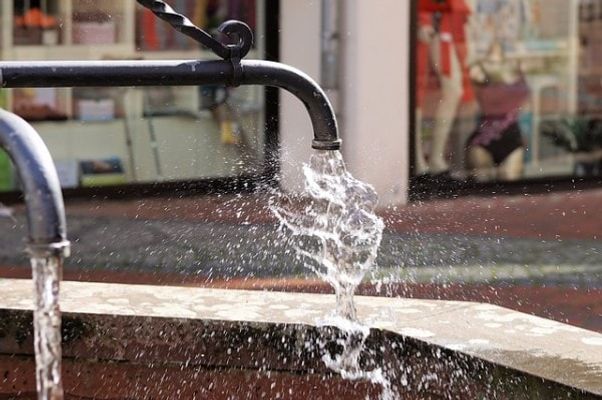7.3.3
Water Insecurity Risk
Water Scarcity Causes Variation in Water Prices
Water Scarcity Causes Variation in Water Prices
The price of water varies across the world, as well as the proportion of the local’s income. This is dependent on a variety of factors including access to water but also the effectiveness of the infrastructure.


Development of water sources
Development of water sources
- Governments have often charged a service fee for access to water. This was particularly established in emerging and developing countries during colonisation.
- As populations have expanded around the basic infrastructure the governments have passed on the responsibility to external businesses - referred to as Privatisation.
- Privatisation often requires residents to pay more to make the investment of these businesses cost effective.


Water Privatisation: Bolivia
Water Privatisation: Bolivia
- In 1999, the water company Agua del Tunari took over the Cochabamba city water system in Bolivia.
- The company raised the prices until they were the equivalent to 20% of the average income.
- Agua del Tunari said that 95% of people had access to the water. The poorest communities could not afford the fee to attach water to their homes so they attached themselves illegally and protested for four days until the Bolivian government cancelled the contract.
Water Poverty Index
Water Poverty Index
The Water Poverty Index was developed in 2002 to help the UN reach the Millenium Development Goals (MDGs). It determines the quality, quantity and accessibility of water. It considers five principles:


Principle one
Principle one
- The quality, quantity and availability of the water resources.


Principle two
Principle two
- The accessibility in terms of distance from water safe to drink, cook and for industrial and agricultural use.


Principle three
Principle three
- Handling capacity considers how affordable the water is and how effective the water management techniques are.


Principle four
Principle four
- The different proportions of water use in terms of domestic, agriculture and industry.


Principle five
Principle five
- Environmental sustainability in terms of the wider ecosystem.
The Importance of Water Supply
The Importance of Water Supply
The water supply is important for economic development, human well-being and environmental problems.


Economic: industry
Economic: industry
- Water supply needs to be of high quality and quantity for consistent industrial productivity. If this fails, it can lead to a reduction or temporary closure on production with large economic impacts.
- Global demand for water to be used in industry is expected to increase by 400% between 2000 and 2050 because this sector is expanding in emerging and developing nations.
- Pollution because of poor management of waste products is a threat that could lead to significantly reduced water supplies.


Economic: energy supply
Economic: energy supply
- The majority of energy generation - especially via the combustion of fossil fuels - needs water in the form of steam to turn turbines that generate electricity.
- Energy demands are increasing globally as electricity access increases and standard of livings improve, demanding more energy.


Economic: agriculture
Economic: agriculture
- There is a need to produce 60% more food by 2050 to feed the evergrowing population.
- It is estimated that by 2050, food production will need 140% more water than it does currently.
- The volume of water being used in agriculture is not sustainable, so we need to develop water-efficient farming methods and crops that need less water.


Human wellbeing: sanitation and health
Human wellbeing: sanitation and health
- Limited access to clean water, (i.e. Nigeria), increases the risk of disease and illness. Drinking unsafe water can give people Cholera that often targets the vulnerable.
- 335,000 children die of water born diseases in Nigeria a year and girls often miss education during menstruation because they have insufficient water for sanitation.
- Locals take out loans to cover the medical expenses - leading to debt.
- A positive correlation between GDP per capita and access to clean safe water exists.
1Tectonic Processes & Hazards
1.1Tectonic Processes & Hazards
1.2Natural Disasters
1.3Natural Disaster Case Studies
1.4Trends & Patterns
2Option 2A: Glaciated Landscapes & Change
2.1Glaciated Landscapes Over Time
2.2Periglacial Landscapes
2.3Glacial Processes
2.4Glacial Landforms
3Option 2B: Coastal Landscapes & Change
3.1Coastal Landscapes
3.2Coastal Erosion & Deposition
3.3Coastal Risks
4Globalisation
4.1Globalisation
4.2Negatives of Globalisation
4.3Global Shift
4.5Culture
4.6Measuring Development
5Option 4A: Regenerating Places
5.1Types of Economies
5.2Function of Places
5.3Regeneration
5.4Regeneration Case Studies
6Option 4B: Diverse Places
6.1Population Structure
6.2Past & Present Connections
6.3Urban & Rural Spaces
6.4Diversity
6.5Urban & Rural Case Studies
6.6Case Study - Tower Hamlets
6.7Case Study - Sturton-le-Steeple
7The Water Cycle & Water Insecurity (A2 only)
7.1Hydrological Processes Global to Local
7.2Influences on the Water Cycle
7.3Water Insecurity
8The Carbon Cycle & Energy Security (A2 only)
8.1The Carbon Cycle
8.2Energy Consumption
8.3Alternative Energy
8.4Growing Demand for Resources
9Superpowers (A2 only)
9.1Superpowers
9.2Hard & Soft Power
9.2.1Hard & Soft Power
9.2.2Emerging Powers - China Rivalry
9.2.3Emerging Powers - Chinese Sources of Power
9.2.4Emerging Powers - Brazil
9.2.5Emerging Powers - Russia
9.2.6Emerging Powers - India
9.2.7Theories of Development
9.2.8Power Case Studies: Chinese One Belt One Road
9.2.9Power Case Studies: Pakistan Nuclear Arms
9.2.10Power Case Studies: OPEC
9.3IGOs, TNCs & Alliances
10Option 8A: Health & Human Rights (A2 only)
10.1Human Development
10.2Role of Governments & IGOs
10.3Human Rights
10.4Interventions
11Option 8B: Migration & Identity (A2 only)
11.1Globalisation & Migration
11.2Consequences of Migration
11.3Nation States
11.4Responses to Global Migration
Jump to other topics
1Tectonic Processes & Hazards
1.1Tectonic Processes & Hazards
1.2Natural Disasters
1.3Natural Disaster Case Studies
1.4Trends & Patterns
2Option 2A: Glaciated Landscapes & Change
2.1Glaciated Landscapes Over Time
2.2Periglacial Landscapes
2.3Glacial Processes
2.4Glacial Landforms
3Option 2B: Coastal Landscapes & Change
3.1Coastal Landscapes
3.2Coastal Erosion & Deposition
3.3Coastal Risks
4Globalisation
4.1Globalisation
4.2Negatives of Globalisation
4.3Global Shift
4.5Culture
4.6Measuring Development
5Option 4A: Regenerating Places
5.1Types of Economies
5.2Function of Places
5.3Regeneration
5.4Regeneration Case Studies
6Option 4B: Diverse Places
6.1Population Structure
6.2Past & Present Connections
6.3Urban & Rural Spaces
6.4Diversity
6.5Urban & Rural Case Studies
6.6Case Study - Tower Hamlets
6.7Case Study - Sturton-le-Steeple
7The Water Cycle & Water Insecurity (A2 only)
7.1Hydrological Processes Global to Local
7.2Influences on the Water Cycle
7.3Water Insecurity
8The Carbon Cycle & Energy Security (A2 only)
8.1The Carbon Cycle
8.2Energy Consumption
8.3Alternative Energy
8.4Growing Demand for Resources
9Superpowers (A2 only)
9.1Superpowers
9.2Hard & Soft Power
9.2.1Hard & Soft Power
9.2.2Emerging Powers - China Rivalry
9.2.3Emerging Powers - Chinese Sources of Power
9.2.4Emerging Powers - Brazil
9.2.5Emerging Powers - Russia
9.2.6Emerging Powers - India
9.2.7Theories of Development
9.2.8Power Case Studies: Chinese One Belt One Road
9.2.9Power Case Studies: Pakistan Nuclear Arms
9.2.10Power Case Studies: OPEC
9.3IGOs, TNCs & Alliances
10Option 8A: Health & Human Rights (A2 only)
10.1Human Development
10.2Role of Governments & IGOs
10.3Human Rights
10.4Interventions
11Option 8B: Migration & Identity (A2 only)
11.1Globalisation & Migration
11.2Consequences of Migration
11.3Nation States
11.4Responses to Global Migration
Unlock your full potential with Seneca Premium
Unlimited access to 10,000+ open-ended exam questions
Mini-mock exams based on your study history
Unlock 800+ premium courses & e-books